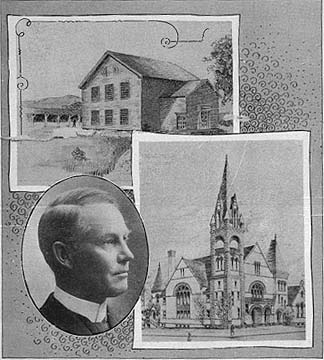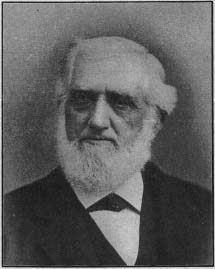|
Sketch of Holyoke by George H. Allyn, page 6 In Exchange Hall had been held the concerts, lectures, society, religious, and public meetings for a score of years. The writer as a small boy in about 1868 recalls the velocipede craze. The velocipede was a caricature of the later high-wheel bicycle without the chain. A high speed could be attained on a smooth level surface, but it was practically impossible to ride up hill. Exchange Hall was headquarters for the craze at its height, and staid citizens would pay fifty cents for the privilege of whirling around the hall, and taking a flying dive when they tried to make a sharp turn. Thomas W. Mann and John J. Prew thought they saw "millions in it," and invested in several velocipedes for a tour through Connecticut. The mechanical construction of the machines was faulty and they would break right at the "neckyoke." Mr. Prew said it was worth a dollar to see the gaze with which the country blacksmiths, to whom they took the machines, regarded them. Finally Mr. Prew traded his share in the venture for a pair of boots and returned home. His brother, Joseph N. Prew, entered the photographic business in 1861, at the age of eighteen years and continued till 1877. First located in the Hutchins' block, corner of High and Hampden streets, he later removed to the Fuller block, and still later moved across the street again. The sign, "Prew's Picture Rooms," extended clear across the street. Joe is also reported to have secured many volunteers for the war, some of whom sent home cordial assurances that they'd kill him when they returned. He still survives, however, and Holyoke would miss his cheery countenance and the sound of his booming voice. In 1864 the Colby block, next to where the Holyoke National bank now stands, had been built and was afterwards sold to W.C. Carter, who kept stores there. Later, by inheritance, it came to W.C. Heywood and is now owned by Louis Strauss. The block now occupied by the Atherton store seems to have been built by J.C. Parsons in the 60's, and later was owned by "Jim" Meacham, the jeweler, with whom T.J. Morrow learned his trade. Later B.F. Lincoln bought it and his son still retains it. R.G. Marsh had also built the property now known as the Park Pharmacy, and George M. Wolcott bought in 1862 the lot on the corner of High and Dwight streets, on which he built in 1879, and which is now the McAuslan & Wakelin corner. The Orrell block, at the corner of High and Hampden streets, was also built in the early 60's, and Main street, below Dwight began to build up in this decade. A young man from Vermont, named Charles Corser, came to the town, and shortly after opened a shoe store nearly opposite. It is related that when he struck the town he was unable to pay his boarding master for several weeks, and one morning the latter remonstrated with him: "See here, Corser, if you think I can board people for six or seven weeks without a cent of money, you're mistaken." "Why don't you sell out to someone that can, then?" replied the imperturbable Corser. Mr. Corser was the first natural advertising genius among the merchants.
 First Congregational Church
 W.B. Whiting
The war was ended; a host of workshops and workers had come in, and the courage of Holyoke's pioneers was high. But as there was no suburban development, and the business section was largely confined to a small part of the present High street and a few stores near the corner of Dwight and Main streets. A. & S.B. Allyn had built a block at the corner of High and Dwight streets, where the Holyoke Realty Trust building now stands, but they found it a little too far south, and sold it in 1869 so as to erect a building farther north. From Lyman to John streets on High was the best business center, and the Exchange block, a little south of Lyman street on the west side, was regarded as the creme de la creme of business locations, and when it burned to the ground, Holyoke felt it as a crushing blow.
| Previous Page | Next Page |
| People & Organizations | Allyn's Sketch of Holyoke |
| Selected Advertisments | Churches | Surname Index |
© Laurel O'Donnell 1996 - 2005, all rights reserved
This document may be downloaded for personal non-commercial use only and should not be reproduced or distributed without permission. |